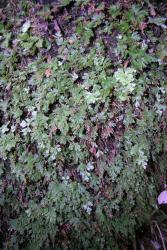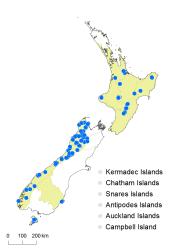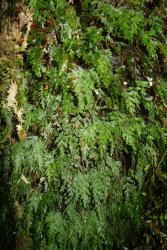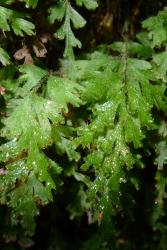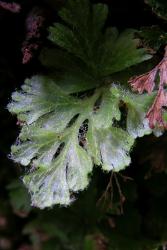- ≡ Mecodium rufescens (Kirk) Copel., Philipp. J. Sci. 67: 21 (1938)
Epiphytic, terrestrial or rupestral ferns. Rhizomes long-creeping, 0.2–0.4 mm diameter, bearing abundant fine pale brown hairs up to 1 mm long, clustered at bases of stipes. Fronds 25–130 mm long. Stipes 8–85 mm long, pale brown or red-brown, not winged, bearing villous pale brown or whitish hairs throughout. Laminae 1-pinnatifid to 1-pinnate-bipinnatifid, ovate or triangular, 8–55 mm long, 7–50 mm wide, yellow-green, membranous, with abundant villous pale brown or whitish hairs up to 2 mm long on costae and lamina surfaces, often clustered at bases of indusial flaps. Rachises narrowly winged in distal half, pale brown or red-brown, bearing villous pale brown hairs; rachis wings planate. Primary pinnae in 1–6 pairs, not overlapping, winged; distal portion of primary pinnae straight or slightly incurved acroscopically; distal primary pinnae elliptic or obovate, adnate; proximal primary pinnae flabellate or ovate, adnate or stalked in very large fronds; the longest primary pinnae at or near the base, 4–26 mm long, 3–19 mm wide. Secondary pinnae arising both acroscopically and basiscopically, not overlapping, winged throughout, oblong or obovate, adnate; the longest secondary pinnae 4–18 mm long, 2–9 mm wide. Ultimate lamina segments oblong, up to 4 mm long, 0.8–1.2 mm wide; apices obtuse; margins entire, lacking a distinct border; distal segments on primary pinnae not curved towards frond apex. Sori borne on acroscopic and basiscopic segments at the distal ends of the pinnae, solitary on each segment, many on each primary pinna, adnate or partially immersed in lamina; indusia bivalvate; indusial flaps ovate or elliptic or broader than long, 0.75–1 mm long, apices obtuse or truncate, margins entire or shallowly toothed, outer surfaces with occasional villous hairs; receptacles included within indusial flaps.
Hymenophyllum rufescens is recognised by its fronds with usually small triangular laminae abundantly covered in villous pale brown hairs, and stipes which are as long as, or longer than, the laminae. It is closely related to H. flabellatum but grows at higher altitudes, and can usually be distinguished by its smaller and much hairier laminae. Intermediate forms are sometimes found in areas where the two species meet, but whether these are hybrids is unclear.
North Island: Auckland, Volcanic Plateau, Gisborne, Taranaki, Southern North Island.
South Island: Western Nelson, Westland, Otago, Fiordland.
Stewart Island.
Altitudinal range: 60–1250 m.
Hymenophyllum rufescens is an uncommon species of montane areas in the North Island recorded from Mt Honokawa and Mt Te Aroha, south to the Ruahine Ranges, ranging from 650 to 1250 m. It is more common in lowland and montane areas of the South Island but found only west of the main divide except for an outlying population near Dunedin (AK 215140). It occurs from 60 m in the lower Buller Gorge to 1100 m on Mt Arthur.
Occurs in podocarp, beech and broadleaved forest growing on rocks, banks, rotten logs and stumps, on tree roots, the bases of tree trunks and as a low epiphyte on the trunks of Dacrydium cupressinum, Libocedrus bidwillii, Metrosideros umbellata, Podocarpus laetus, and on species of Phyllocladus, Quintinia and Nothofagaceae. It has not been recorded from tree fern trunks.
n = 36 (Brownlie 1965).
The original lectotype designated by Allan (1961, p. 26) has been lost and a replacement lectotype selected by Brownsey & Perrie (2016).
DNA sequencing suggests that Hymenophyllum rufescens is clearly distinct from both Australian and New Zealand populations of H. flabellatum (Perrie et al. 2016).



